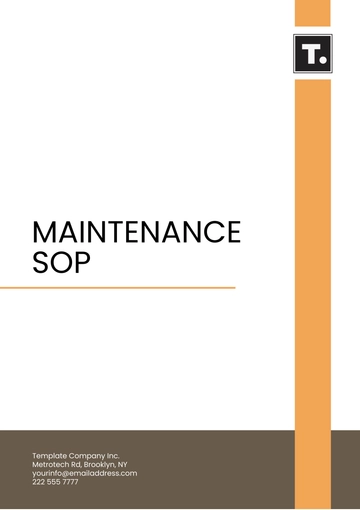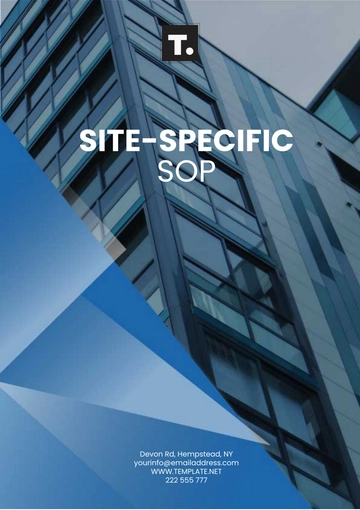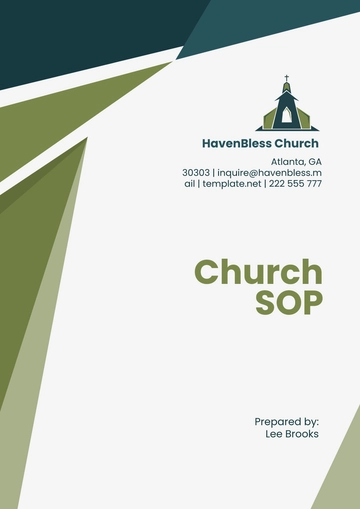Free Sales Lead Engagement SOP

1. Purpose
The primary purpose of this Sales Lead Engagement Standard Operating Procedure (SOP) is to establish a well-defined and systematic framework that empowers the sales team at [Your Company Name] to engage with potential customers effectively. This SOP serves as a guiding document to achieve the following specific objectives:
Enhance Sales Efficiency: This SOP is designed to streamline the sales lead engagement process, ensuring that all team members follow a standardized approach. By doing so, it aims to maximize the efficiency of the sales team, enabling them to handle a higher volume of leads without compromising quality.
Optimize Lead Conversion: The core purpose of engaging with potential customers is to convert them into paying customers. This SOP outlines the steps, techniques, and best practices required to increase lead conversion rates, ultimately driving revenue growth for [Your Company Name].
Build Long-Term Customer Relationships: Beyond immediate sales, this SOP emphasizes the importance of fostering long-term customer relationships. By consistently delivering exceptional service and personalized interactions, the brand aims to transform one-time buyers into loyal, repeat customers who not only make future purchases but also become brand advocates.
Ensure Consistency: Maintaining consistency in lead engagement is crucial for projecting a professional image of [Your Company Name]. This SOP establishes standardized procedures and communication guidelines, ensuring that every lead receives a uniform and high-quality experience.
Enhance Brand Reputation: Engaging with potential customers in a structured and customer-centric manner enhances the brand's reputation. By consistently providing value, addressing customer needs, and exceeding expectations, [Your Company Name] aims to be recognized as a trusted and reputable player in the clothing industry.
Facilitate Continuous Improvement: The SOP also serves as a basis for ongoing assessment and improvement. By tracking key performance indicators (KPIs) and collecting feedback from sales interactions, the brand can identify areas for enhancement and implement changes to continually elevate the lead engagement process.
In summary, this Sales Lead Engagement SOP is designed to align the efforts of the sales team with the overarching goals of [Your Company Name], including revenue growth, customer relationship development, and brand reputation enhancement. It is a dynamic document that guides and evolves the approach to engaging with potential customers to ensure lasting success in a competitive market.
2. Scope
This Sales Lead Engagement Standard Operating Procedure (SOP) outlines a comprehensive framework that encompasses the entire spectrum of activities related to engaging potential customers, from the initial lead generation to post-conversion follow-up. The scope of this SOP is defined as follows:
Lead Generation: This SOP addresses the processes and protocols for generating leads, including the identification and qualification of potential customers through various marketing channels. It encompasses strategies for attracting potential customers through methods such as social media, website interactions, email campaigns, and participation in events.
Lead Qualification: The SOP includes guidelines for assessing and qualifying leads based on predetermined criteria, such as budget, product interest, geographic location, and demographic information. It outlines the criteria that must be met for a lead to be considered qualified and ready for engagement by the sales team.
Initial Contact: This SOP provides a structured approach for initiating the first contact with potential customers. It outlines methods for introducing [Your Company Name], establishing rapport, and conducting initial fact-finding conversations to understand the lead's specific needs and preferences.
Product Presentation: The scope of this SOP extends to the presentation of [Your Company Name]'s products and services. It includes guidelines for tailoring product presentations to match the lead's identified needs and preferences, as well as recommendations for highlighting unique selling points and benefits.
Overcoming Objections: This SOP addresses strategies and best practices for handling objections and concerns raised by potential customers. It emphasizes active listening, empathy, and the provision of solutions to address objections effectively.
Closing the Sale: The SOP covers the essential steps involved in proposing offers, including pricing, payment options, and incentives, as well as techniques for prompting potential customers to make a purchase decision. It provides guidance on securing the sale and facilitating a seamless transaction.
3. Definitions
3.1 Sales Lead
Definition: A "Sales Lead" refers to an individual or entity that has demonstrated a genuine interest in the products or services offered by [Your Company Name]. This interest may be indicated through various actions, such as website visits, inquiries, subscription to newsletters, or engagement with marketing campaigns.
3.2 Conversion
Definition: "Conversion" is the pivotal process within the sales lead engagement journey that involves successfully turning a prospective lead into a paying customer. It marks the transition from a lead's interest or inquiry to the completion of a transaction, which may involve making a purchase, signing a contract, or committing to a desired action.
3.3 CRM
Definition: "CRM" stands for "Customer Relationship Management." It refers to a comprehensive software system or platform used by [Your Company Name] to effectively manage and maintain interactions with leads and customers throughout the entire sales cycle. CRM systems enable lead tracking, data organization, communication management, and customer relationship nurturing.
These definitions are essential for clarifying key concepts and terms used throughout the Sales Lead Engagement SOP, ensuring that all team members have a shared understanding of these fundamental elements in the lead engagement process.
4. Responsibilities
4.1 Sales Team
Primary Responsibility: The Sales Team is primarily responsible for the successful implementation of the lead engagement process from initial contact to conversion. This includes:
Actively engaging with leads in a professional and customer-centric manner.
Conducting thorough needs assessments and product presentations tailored to individual lead preferences.
Effectively addressing objections and concerns to facilitate the conversion process.
Closing sales by proposing offers, providing pricing details, and guiding leads through the purchase process.
4.2 Marketing Team
Primary Responsibility: The Marketing Team is primarily responsible for generating and nurturing leads to provide the Sales Team with qualified prospects. This includes:
Strategically planning and executing lead generation campaigns across various channels, including digital, social media, email, and events.
Creating and disseminating marketing materials, such as advertisements, brochures, and online content, to attract potential customers.
Qualifying leads based on predefined criteria before passing them to the Sales Team for engagement.
4.3 Customer Service Team
Primary Responsibility: The Customer Service Team plays a crucial role in post-conversion follow-up and ensuring customer satisfaction. Responsibilities include:
Sending personalized thank-you messages or emails to customers after their purchases.
Monitoring and tracking order fulfillment and delivery to ensure a smooth and timely process.
Actively seeking feedback from customers about their experiences with [Your Company Name]'s products and services.
These responsibilities are essential for creating a clear division of tasks and accountabilities among teams and individuals involved in the lead engagement process. This clarity helps maintain efficiency and effectiveness throughout the customer journey, from lead generation to post-conversion customer support.
5. Sales Lead Engagement Process
5.1 Lead Generation
A. Lead Generation Methods
Social Media: The Marketing Team actively maintains and promotes [Your Company Name]'s presence on social media platforms, including but not limited to Facebook, Instagram, Twitter, and LinkedIn. Strategies may include creating engaging content, running targeted ads, and fostering user interactions to attract potential leads.
Website: The brand's official website serves as a central hub for lead generation. The Marketing Team continuously optimizes the website for search engines (SEO), designs user-friendly landing pages, and implements lead capture forms to collect visitor information.
Email Campaigns: The Marketing Team plans and executes email marketing campaigns that provide valuable content and incentives to subscribers, encouraging them to become leads. Email lists are segmented for personalized targeting.
5.2 Lead Qualification
B. Lead Review and Assessment
Predefined Criteria: The Sales Team uses predefined criteria to assess the quality and readiness of each lead. These criteria may include budget constraints, product interest, location, and other factors deemed relevant.
Lead Scoring: Leads are assigned a numerical score based on their alignment with the predefined criteria. A lead scoring system helps prioritize leads for engagement, ensuring that resources are allocated efficiently.
Information Verification: The Sales Team verifies lead information for accuracy, ensuring that contact details and other data are current and valid.
6. Sales Lead Management
Effective sales lead management is essential for maintaining a structured and organized approach to engage with potential customers. This section outlines the processes and practices related to managing leads within the CRM system:
6.1 Recording Interactions
A. Comprehensive Documentation: All interactions with leads, including communication history, meetings, inquiries, and follow-up activities, are diligently recorded in the CRM system. This documentation should be thorough, capturing key details of each interaction, such as date, time, mode of communication, and the nature of the conversation.
B. Integration: The CRM system should be integrated with communication tools (e.g., email, phone systems) to automatically log interactions whenever possible, minimizing manual data entry.
6.2 Updating Lead Statuses
A. Lead Status Definitions: Define specific lead statuses within the CRM system that reflect the lead's progress through the sales funnel. Common statuses may include "New Lead," "Contacted," "Qualified," "Proposal Sent," and "Closed-Won" or "Closed-Lost."
B. Regular Status Updates: Sales representatives are responsible for regularly updating lead statuses based on their engagement progress. This ensures that the entire team has a real-time understanding of each lead's status.
C. Lead Movement Workflow: Develop a workflow that dictates how leads move from one status to another. For instance, a lead may transition from "Contacted" to "Qualified" after a successful initial conversation.
7. Training and Development
Ongoing training and skill development are vital components of maintaining a high-performing sales team capable of effectively engaging leads. This section outlines the practices and strategies related to continuous improvement:
7.1 Continuous Training Programs
A. Training Needs Assessment: Regularly assess the training needs of the sales team to identify gaps in knowledge and skills. This assessment may involve surveys, performance evaluations, and feedback sessions.
B. Training Curriculum: Develop a comprehensive training curriculum that covers various aspects of lead engagement, including communication techniques, objection handling, product knowledge, and use of the CRM system.
C. Training Modules: Break down the curriculum into modular training sessions, making it easier for sales team members to focus on specific areas for improvement.
7.2 Role Play and Simulation
A. Practical Exercises: Conduct role-playing exercises and simulations that allow sales team members to practice lead engagement techniques in a controlled environment.
B. Feedback: Provide constructive feedback and coaching based on performance in role-playing scenarios to help team members refine their skills and overcome challenges.
7.3 External Training Resources
A. Industry Seminars and Workshops: Encourage sales team members to attend industry-specific seminars, workshops, and conferences to stay updated on the latest trends and best practices in lead engagement.
B. External Training Providers:* Consider partnering with external training providers or consultants who specialize in sales and lead engagement to bring fresh perspectives and expertise to the team.
8. Key Performance Indicators
Key Performance Indicators (KPIs) are essential metrics used to evaluate the effectiveness and success of the lead engagement process. Monitoring these KPIs provides valuable insights into the performance of the sales team and enables data-driven decision-making:
8.1 Conversion Rate
Definition: The "Conversion Rate" represents the percentage of leads that successfully transition into paying customers. It is calculated by dividing the number of converted leads by the total number of leads engaged.
Purpose: The Conversion Rate KPI measures the sales team's ability to turn potential customers into actual customers. A high conversion rate indicates effective lead engagement and sales strategies.
8.2 Lead Response Time
Definition: "Lead Response Time" is the average time it takes for a sales representative to respond to a lead's initial inquiry or contact attempt. It is measured from the moment a lead expresses interest to the moment they receive a response.
Purpose: Lead Response Time is a critical KPI as it reflects the brand's commitment to timely customer engagement. Quick responses increase the likelihood of lead conversion and improve the overall customer experience.
8.3 Customer Satisfaction
Definition: "Customer Satisfaction" measures the level of contentment and positive sentiment expressed by customers who have engaged with [Your Company Name]. It is typically assessed through surveys, feedback forms, and post-purchase interactions.
Purpose: Customer Satisfaction KPI is a direct indicator of the quality of lead engagement and post-conversion follow-up. High customer satisfaction levels lead to customer loyalty, repeat business, and positive word-of-mouth referrals.
9. Approval
This section outlines the formal approval process for the Sales Lead Engagement SOP, ensuring that the document has undergone the necessary reviews and endorsements by relevant department heads. The approval process involves the following steps:
A. Review and Revision
Before formal approval, the Sales Lead Engagement SOP should undergo a thorough review by key stakeholders, including members of the Sales Team, Marketing Team, Customer Service Team, and senior management.
Any identified issues, inconsistencies, or areas for improvement should be addressed and incorporated into the SOP through a revision process.
B. Endorsement by Department Heads
The SOP document should be presented to the department heads responsible for the Sales Team, Marketing Team, and Customer Service Team.
Each department head should review the SOP to ensure that it aligns with their team's responsibilities and objectives.
C. Signature and Date of Approval
Once the department heads are satisfied with the content of the SOP, they should provide their formal approval by signing the document.
The signature should be accompanied by the date of approval, indicating the specific date on which the SOP was officially endorsed.
D. Distribution of Approved SOP
After approval, the SOP should be distributed to all relevant team members within the Sales, Marketing, and Customer Service teams.
Ensure that team members are informed of the SOP's approval and are provided with access to the updated document.
E. Document Control
Maintain a controlled version of the approved SOP to track any future revisions or updates.
Clearly designate the latest version of the SOP and archive previous versions for reference.
By implementing a formal approval process, [Your Company Name] ensures that the Sales Lead Engagement SOP has the necessary buy-in from department heads and key stakeholders, reinforcing its significance as a guiding document for the organization's lead engagement efforts. This process helps maintain consistency, quality, and alignment with the brand's objectives throughout the lead engagement process.
- 100% Customizable, free editor
- Access 1 Million+ Templates, photo’s & graphics
- Download or share as a template
- Click and replace photos, graphics, text, backgrounds
- Resize, crop, AI write & more
- Access advanced editor
Introducing the Sales Lead Engagement SOP Template, available exclusively on Template.net. Tailored for sales professionals, this editable and customizable document outlines standard operating procedures for engaging leads effectively. Utilize our AI Editor Tool to define lead qualification criteria, communication protocols, and follow-up strategies with precision. Streamline your lead management process and optimize conversion rates effectively.





























